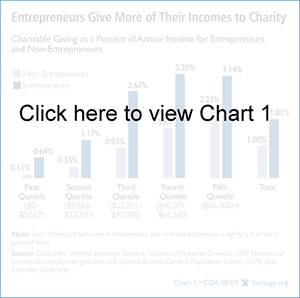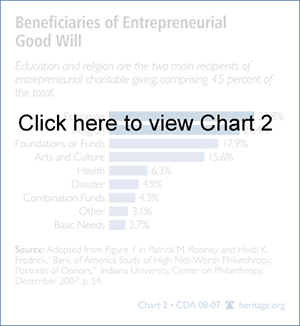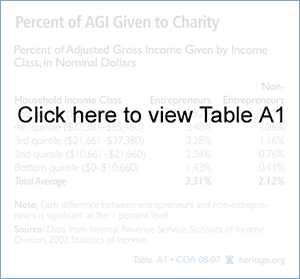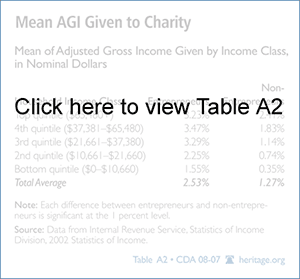An enduring criticism of free markets is that they are based on self-centered greed. Commentators on the left deride American capitalism as "You're on your own" economics, in contrast to the social democratic vision of "We're in this together."[1]
Many observers admit that free markets create immense wealth and high standards of living, but also believe free markets encourage self-interest and reward greed. Seeking to earn Bill Gates's level of wealth can seem inherently selfish.
But the fact that the American economy rewards individual initiative does not signify that it promotes greed. In this paper, evidence is presented that supports that the philanthropic actions of entrepreneurs, measured by the size of their charitable contributions as a portion of income, are 80 percent greater than the rest of the population. This suggests that those who benefit the most from the free market are motivated by more than narrow self-interest -- and give the most back.
Tradition of Philanthropic Entrepreneurs
In America, entrepreneurship and philanthropy have always been closely linked. One prominent example is Andrew Carnegie, who first came to America as a poor immigrant and later earned hundreds of millions of dollars in the steel industry. He used his vast fortune to serve others, building 3,000 public libraries across the United States. By the end of his life, he had given away almost all his fortune. Philanthropic entrepreneurs are hardly a remnant of the past, having always had a place in American society and the economy. Today, Bill Gates is the classic wealthy entrepreneur, and few of his fellow Americans consider him greedy. The Bill and Melinda Gates Foundation is the largest charitable foundation in the world and has donated billions of dollars to prevent AIDS, offer college scholarships to minorities, and fight diseases in the developing world.
To determine whether charitable giving by entrepreneurs is exceptional or typical, The Heritage Foundation examined a sample of tax returns with reported charitable deductions that the IRS discloses through its Statistics of Income Division. This allows us to compare charitable giving of entrepreneurs with the rest of the population.
For the purposes of this paper, entrepreneurs are considered tax filers who report more self-employment or business income than wage and salary income. We exclude those with negative business income. Non-entrepreneurs are considered those who report no self-employment or business income. This allows for comparisons of those who run their own businesses -- a common understanding of an entrepreneur -- to those who remain in an employment relationship with an already-established business. Details of these definitions are in the appendix.
Entrepreneurs Give More to Charity
Chart 1 examines entrepreneurial giving as a percent of adjusted gross income by income quintile. Entrepreneurs give substantially more of their income to charity than do non-entrepreneurs.
Interestingly, this is true at all income levels, not just for successful entrepreneurs. Even entrepreneurs with low incomes give generously. Entrepreneurs in the bottom quintile donate 0.6 percent of their income. This is more than six times the rate for non-entrepreneurs in the bottom quintile. Entrepreneurs in the middle quintile give 2.7 percent of their income to charity, triple the 0.9 percent that non-entrepreneurs give in the same quintile.
It is also true at the top. Entrepreneurs in the wealthiest fifth of the population contribute 3.1 percent of their income, compared to 2.2 percent among non-entrepreneurs. Overall, the typical entrepreneur donates 1.8 percent of his income, compared to 1 percent for the person not running his own enterprise. In other words, the average entrepreneur gives 80 percent more of his income than someone who does not work for himself or does not own his own business.
Entrepreneurs Give to Give Back
Why do entrepreneurs give more to charity than their peers? The typical entrepreneur is motivated to give by the same causes that drive giving by non-entrepreneurs. There are several important factors that especially motivate entrepreneurs to give. A recent survey of high net-worth philanthropists showed that entrepreneurs are significantly more likely to give to charity than their peers with comparable incomes and net worth in order to set a good example for their peers and children, or if they believe that nonprofits could provide a service that the government cannot.[2] Entrepreneurs are also more likely to give if they believe that a charity meets a critical need because they believe that giving is a way to give back to society, or if they think that those with more should contribute to those with less.[3]
Who are the recipients of the donations from entrepreneurs? As Chart 2 illustrates, philanthropic entrepreneurs appear to be strong believers in the diversification of their charitable donations. Entrepreneurs contribute to educational organizations more often than to any other group; nearly 80 percent of their charitable donations are given to organizations supporting art, culture, religion, or education, or to a foundation or charitable fund.[4] Similar to their peers, successful entrepreneurs rarely give to organizations that support basic needs, health care, or disaster relief.[5] Perhaps these are examples of government aid obstructing private assistance.
When compared with their peers, entrepreneurs make substantially larger contributions to secular charities and educational organizations. Entrepreneurs give, on average, about 81 percent more to secular causes and about 121 percent more to educational organizations than do non-entrepreneurs.[6]
The evidence suggests that the typical entrepreneur tends not to believe in a "You're on your own" society. Although policymakers do not need to create incentives to encourage entrepreneurs to give even more, they can encourage continued entrepreneurial donations by eliminating taxes that constrain charitable giving. In fact, of the 76 high net-worth entrepreneurs surveyed for the "Bank of America Study of High Net-Worth Philanthropy," more than 36 percent said that they would designate more to charity in their wills, while more than 19 percent said they would designate "dramatically more" to charity, if Congress were to repeal the death tax.[7]
Conclusion
Free markets rely on the entrepreneurial spirit, but that urge to create, innovate, and succeed is not grounded in self-centeredness. Entrepreneurs are no greedier than anyone else. On the contrary, the typical entrepreneur gives generously from the wealth he creates. Believing that government redistribution of wealth is harmful for the economy does not signify supporting a society where "You're on your own." Free markets enable entrepreneurs to become very wealthy -- and they often use this wealth to benefit others.
Guinevere Nell is Research Programmer, James Sherk is Bradley Fellow in Labor Policy, and Paul L. Winfree is a Policy Analyst in the Center for Data Analysis at The Heritage Foundation.
Appendix
Microdata from the Statistics of Income (SOI)[8] public-use database from the years 1999 and 2002 were used to compare tax filers who reported a greater gross income using Schedule C than as regular income on their 1040 tax forms. Data from 1999 were statistically merged by The Heritage Foundation with Current Population Survey (CPS)[9] data from the same year.
In order to determine the generosity of the individual giving, the percent of adjusted gross income (AGI) given was determined in two ways. First, the percent of AGI given by individual filers was tracked for each type (entrepreneur versus non-entrepreneur), and the mean of the percent given by each income class was found. (See Table A1.) For example, one filer gives 10 percent of his income and another gives 14 percent. Their individual donations would average a rate of 12 percent.
Second, we compared a mean of contributions by filers of each type -- entrepreneurs and non-entrepreneurs -- with the mean of the AGI of filers of those types in each income quintile. (See Table A2.) This represents the total generosity of each income class, for each group. For example, one filer in the middle quintile earns $35,000 and gives $4,000 to charity. Another earns $45,000 and donates $2,000. Collectively, they gave an average of $3,000 on an average income of $40,000, for an average donation rate of 7.5 percent.
All dollar figures are expressed in nominal dollars.






